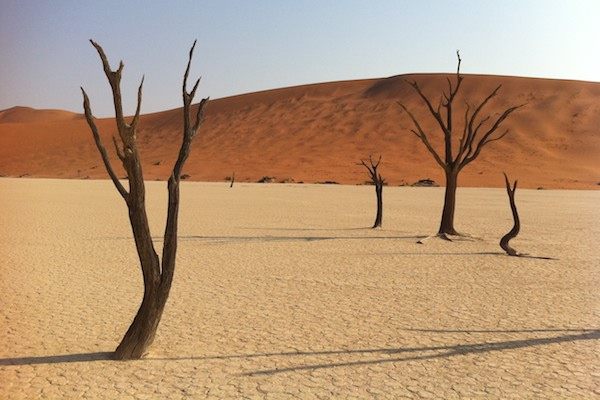What Does a Seven-Legged Gnacien Look Like? Disputed Likenessess of Kcymaerxthaere
From August to September, Eames Demetrios, Geographer-at-Large for Kcymaerxthaere, is serving as the Geographer-in-Residence at Atlas Obscura. His Kcymaerxthaere explores the lines of a world parallel to our own with historic markers around the world.
I have always been interested in the idea that in any culture that makes representations of its stories, religious and otherwise, one can often see very different depictions of the same character or story, and yet everyone who sees these images knows they are the same person. It is true of the Ganesh (the god with the elephant head) who is seen in myriad, but clearly expressed, ways all over India. It is true of Christian saints like St. Sebastian — who despite many differences in the individual person’s physical features from painting to painting — were often recognizable because of talismanic items in their presentation (for St. Sebastian it was the martyrdom in arrows). It is even true today, when James Bond has been played by six different men, and yet we accept that each is the same character.
Here are Andrea Mantegna and El Greco’s depictions of St. Sebastian as examples:
Andrea Mantegna, “St. Sebastian” (1457-59), oil on wood (via Kunsthistorisches Museum); El Greco, “El martirio de San Sebastian” (1577-78), oil on canvas (via Museo Catedralicio, Palencia)
What I think that means is that there is part of the human programming that permits our visualizations to be clusters of understandings, not literal representation.
So as Kcymaerxthaere began to expand, and I wanted to share such visualizations, I realized that I wanted to be sure there was this kind of visual richness and ambiguity. I wanted to create a story and a universe, but I wanted it to be conjured up fresh in each reader’s imagination and experience. From this came the notion of a disputed likeness — something looked like the character or creature, but did not have to be a photographic representation.
Rather than one official version, I liked the notion that the image would start with the story — whether right after a talk of mine, or from reading the text. Because remember (from an earlier post), these stories are new stories, created by me for Kcymaerxthaere, not based on local stories at all. So the visual track record is thin! Though I do some drawings, I have to be careful. After all, if I draw an animal, then people will say, of course he knows what they look like — he wrote it!
So I just started doing it: asking people to draw what they thought I was talking about. One of the first creatures we did this with was the gnacien, a seven-legged, deer-like creature whose prime numbered legs are very nutritious, but whose non-prime-numbered legs are poisonous unto death. Its story was first told here, outside Pedraza in Spain.
Here are four different versions of the beloved gnacien from four continents. One painted on a wall in Spain:
Another embroidered by a woman from the collective known as Penduka in Namibia:
Or this drawing from a Kcymaerxthaere disputed likeness work shop in Marfa, Texas:
Or a wood carving done in Armenia:
All the same, but all different. Each expressing the big idea clearly. Like multiple tellings of the story of Robin Hood.
Here is the story of Nature of the Waters, installed in San Marcos, Texas. It tells the tale of a place, with many hills and valleys, where in every spot the water is exactly the same depth — so, even on the hilltops your houses need stilts.
Here is how one person showed it:
Then there are other creatures, like the dangaroos, the famous war kangaroos of Estrelliia (the initial “k” is silent), who grazed on Harsh Pastures. Dangaroos had armored pouches and could disembowel a man from 20 paces. Here are some representations:
And it is fun!!! I certainly love seeing how people see my stories — but audiences of all ages love the engagement as well. Now this process has expanded in other ways.
In fact, Disputed Likenesses suggest a new way of connection around the world. Because we do workshops in different places all the time, but when you create a card, YOU don’t keep the card, we mail it to someone else who participated in another workshop. It is your gift to a stranger. THEN, you get a card from someone else — maybe even someone in another country. Or this special postmark from New Harmony — home of an upcoming site.
You can see all the cards (including your own — when you do it!) on our website.
Here are some cool interpretations of Hongsedaunts (or Interpreter Villages):
And if you come on the Atlas Obscura/Kcymaerxthaere Caravan weekend after next, you’ll visit New Harmony, Indiana, where we have an ever growing exhibition of the whole disputed likeness experience — and we hope you’ll contribute your drawing. At the end of the residency, we’ll talk about other ways you can participate, even before a workshop comes to your neck of the woods. Here is one girl’s interpretation of Sin Palabras (Speechless):
Our last picture is of the story of Eliala Mei-Ning, the singer whose voice was too beautiful to be concealed, as depicted by the women of Penduka, a collective based in Windhoek, Namibia. You can visit her story here, here, and here.
But here is one embroiderer’s interpretation of the entire story of the singer:
More disputed likenesses at our website devoted to it.
And if you want to participate in the exchange of postcards, please email us: info@kcystories.com.
Til next week, Shoaf,
Eames Demetrios
Geographer-in-Residence










Follow us on Twitter to get the latest on the world's hidden wonders.
Like us on Facebook to get the latest on the world's hidden wonders.
Follow us on Twitter Like us on Facebook